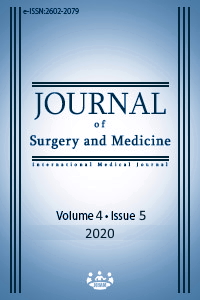Evaluation of peripheral vascular injuries treated with surgery: A retrospective cohort study
Keywords:
Vascular trauma, Vessel repair, Peripheral arterial injuryAbstract
Aim: Vascular injuries constitute 2-3% of the total injuries. Early diagnosis and emergent management of peripheral vascular injuries, which have high mortality and morbidity rates if inadequately managed, are particularly important. In this study, we aimed to evaluate the etiology and treatment results of patients who underwent surgical treatment due to peripheral vascular injury.
Methods: This research was designed as a retrospective cohort study. The etiologies, localizations, accompanying injuries, surgical methods, and results of 57 cases operated due to peripheral arterial injury in Yozgat State Hospital and Bozok University Research Hospital between 2012 and 2019 were evaluated.
Results: Fifty-two patients were male (91.23%) while 5 were female (8.77%). The mean age of all patients was 27.6 (10.5) years (range: 4 - 63 years). Among etiologies, injury due to sharp objects and firearms were significantly higher (n=34 (59.6%) and n=16 (28%), respectively). Traffic accidents were the cause in 5 (8.7%) cases and occupational accidents had occurred in 2 (3.5%) patients. Arterial injuries were detected in 33 (56.89%) upper extremities and 24 (41.87%) lower extremities. End-to-end anastomoses were performed in 29 cases, lateral arteriorrhaphy (primary repair) was performed in 24, autogenous saphenous vein interposition in 4 and ligation was performed in one patient. No cases required fasciotomy or amputation and one patient with a multi-trauma died. A secondary operation was needed for hematoma, thrombectomy, and anastomosis revision in seven, five and three cases, respectively.
Conclusion: In vascular injuries, after ensuring hemodynamic stability, the primary aim is providing the accurate operation approach in the shortest time to reduce morbidity and mortality.
Downloads
References
World Health Organization W. Injury and Violence: the facts 2014. Geneva: World Health Organization; 2014. http://www.who.int/violence injury prevention/media/news/2015/Injury_violence_facts_2014/en/ Accessed 2014.
Krug EG, Sharma GK, Lozano R. The global burden of injuries. Am J Public Health. 2000;90(4):523–6.
Weaver FA, Hood DB, Yelhin AE. Vascular injuries of the extremities. In: Rutherford RB, ed. Vascular Surgery. Philadelphia: Sounders Company, 2000:862-71.
David V Feliciano. Pitfalls in the Management of Peripheral Vascular Injuries. Trauma Surg Acute Care Open. 2017 Aug 28;2(1):e000110 doi: 10.1136/tsaco-2017-000110. eCollection 2017.
Burma O, Uysal A, Özsin KK, Tok R, Köksal H, Rahman A. Periferik dammar yaralanmalarında cerrahi deneyimimiz: 175 olgunun değerlendirilmesi. Turkish J Thorac Cardiovasc Surg. 2005;13(3):252-4.
Gümbel D, Naundorf M, Napp M, Ekkernkamp A, Seifert J. Diagnostik und Management peripherer Gefäß verletzungen [Diagnosis and management of peripheral vascular injuries]. Unfallchirurg. 2014;117(5):445–60. doi: 10.1007/s00113-014-2560-0
Sciarretta JD, Macedo FI, Chung EL, Otero CA, Pizano LR, Namias N. Management of lower extremity vascular injuries in pediatric trauma patients: a single Level I trauma center experience. J Trauma Acute Care Surg. 2014;76(6):1386–9. doi: 10.1097/TA.0000000000000225
Macedo FI, Sciarretta JD, Chausse S, Sleeman D, Pizano LR, Namias N. Vascular Reconstruction Is Not Warranted in Most Civilian Traumatic Shank Vascular Injuries. Ann Vasc Surg. 2016;35:38–45. doi: 10.1016/j.avsg.2016.02.015
Demirel M, Ali İ. Evaluation of trauma patients admitted to the emergency department of in Mogadishu Training and Research Hospital, Somalia: Cross-sectional study of 1106 patients. J Surg Med. 2019:3(10);722-4. doi: 10.28982/josam.626520
Depboylu BC, Külcü N, Yolyapan DA. Periferik Vasküler Yaralanmalarda Deneyimlerimiz: 45 Olgunun Retrospektif İncelenmesi. Damar Cer Der. 2015;24(1):22-8.
Klocker J, Falkensammer J, Pellegrini L, Biebl M, Tauscher T, Fraedrich G. Repair of arterial injury after blunt trauma in the upper extremity - immediate and long-term outcome. Eur J Vasc Endovasc Surg. 2010;39(2):160–4. doi: 10.1016/j.ejvs. 2009.11.019
Gürkan S, Gür Ö, Hüseyin S, Yüksel V, Ünal S, Turan E. Periferik Damar Yaralanmaları: 10 Yıllık Deneyim. Damar Cer Derg. 2012;21(1):34-7.
Tünerir B, Beşoğul Y, Yavuz T, Al-eqaıdat A, Aslan R, Kural T, et al. Periferik Arteriyel Yaralanmalar ve Tedavi Sonuçlar. GKDC Dergisi. 1998;6:151-4.
Yavuz C, Nazlı Y. Periferik damar yaralanmaları. Dicle Med J. 2009:36(3);161-4.
Menakuru SR, Behera A, Jindal R, Kaman L, Doley R, Venkatesan R. Extremity Vascular trauma in civilian population: a seven-year review from North India. Injury. 2005;36(3):400-6.
Parry NG, Feliciano DV, Burke RM, Cava RA, Nicholas JM, Dente CJ, Rozycki GS. Management and short-term patency of lower extremity venous injuries with various repairs. Am J Surg. 2003;186(6):631-5.
Downloads
- 530 1061
Published
Issue
Section
How to Cite
License
Copyright (c) 2020 Zafer Cengiz Er, Kıvanç Atılgan
This work is licensed under a Creative Commons Attribution-NonCommercial-NoDerivatives 4.0 International License.
















